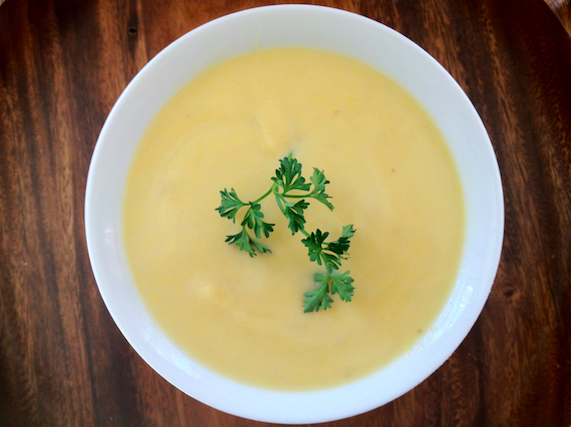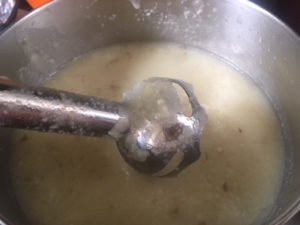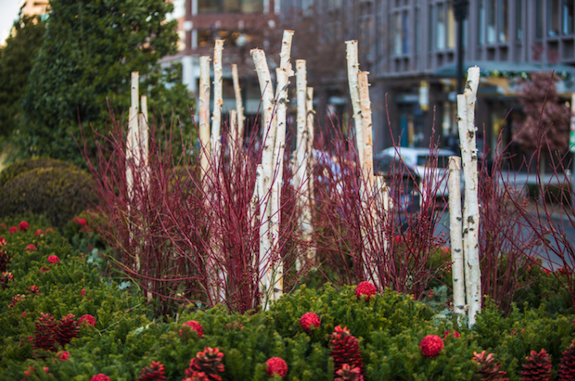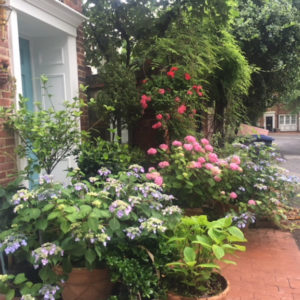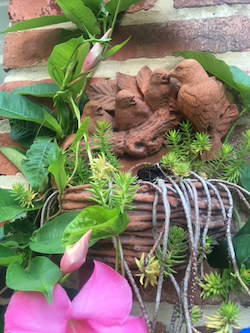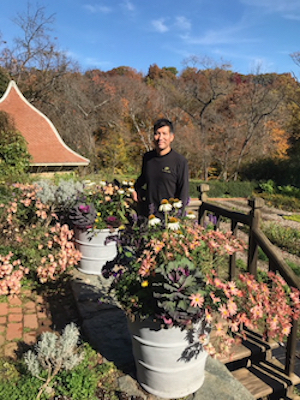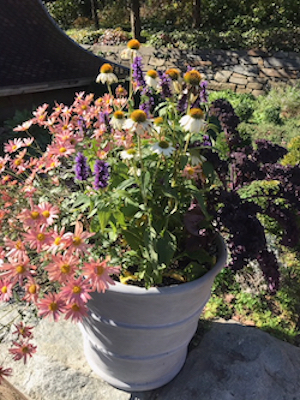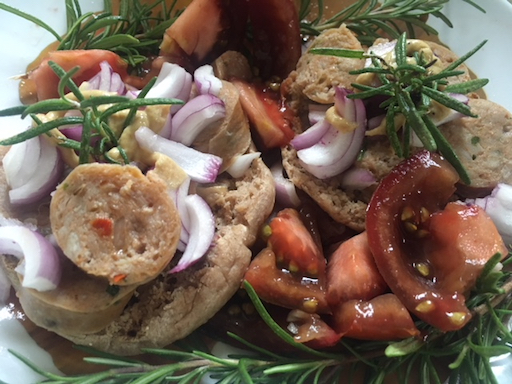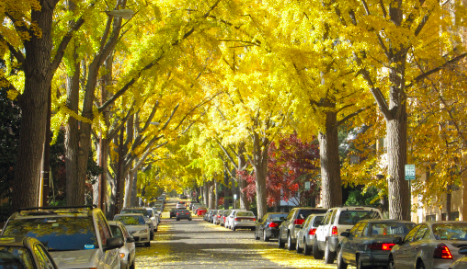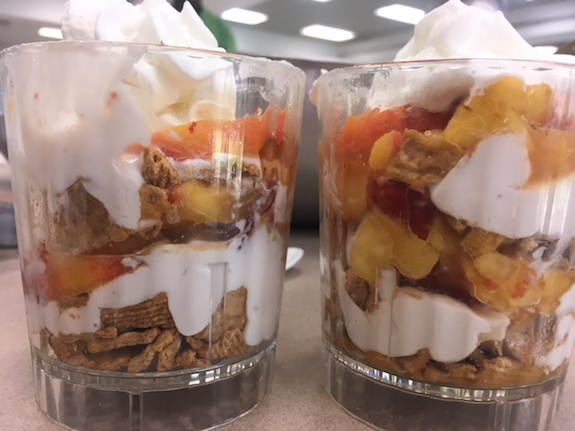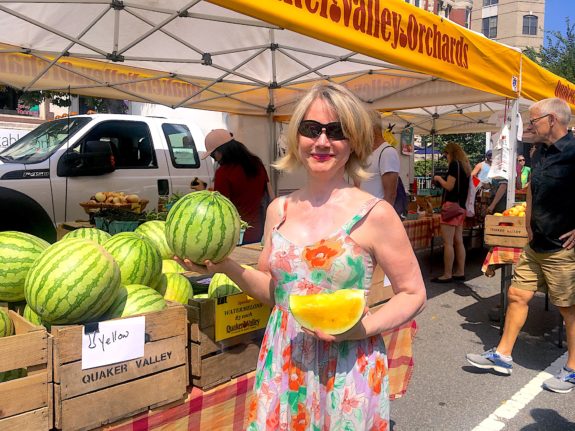This Week’s Batch Recipe: Cauliflower Vichyssoise
My second weekly batch recipe, based on what you can find at your Farmers Market this weekend is Cauliflower Vichyssoise. It is a take on the French Classic Vichyssoise – leak and potato soup – substituting most of the potatoes for cauliflower. Even though Vichyssoise is usally served cold, in the winter I serve my Cauliflower Vichyssoise warm.
Batches are all about making the most of the time you spend in the kitchen and easing some stress from your life. I feature batch recipes in my books, Diet Simple and Diet Simple Farm to Table Recipes. Batches are your favorite delicious, quick and easy meals made ahead of time so that you always have something in the freezer or refrigerator, ready to eat on a moment’s notice. And, believe it or not, even though you’re spending time putting the batch together, overall, it actually saves time.
Soups are some of the best “batches” in the cold dark days of winter. They’re warm, filling, psychologically satisfying and sate the natural urge for comfort food in the winter. Eating soup also makes it easier to lose weight. How?
Classic studies have found that soups are effective weight loss foods. As long as the volume of a food is high (when water or air are incorporated into the food), people can feel full with fewer calories. In one study, researchers varied the water content in three different first courses to see how it would affect peoples’ intake at the main course. The study subjects were fed either 1) chicken rice casserole, 2) chicken rice casserole served with a glass of water, or 3) chicken rice soup – basically the casserole with water/broth added. The researchers found the subjects who ate the soup consumed 26 percent less, about 100 calories fewer, at the main course, compared to the other conditions, even though all three conditions provided the same amount of calories. As I always say, “A calorie isn’t always a calorie!”
Researchers surmise that a large food volume caused by water, even without added calories, helps us feel more satisfied for several reasons. It causes stomach stretching and slows stomach emptying, stimulating the nerves and hormones that signal feelings of fullness. Also, visually seeing a large volume of food can increase your ability to feel satisfied by it, even though the calories are relatively low. Finally, the larger a meal and the longer a meal goes on, studies show, your satisfaction declines and you lose interest in completing it. Water is the component in food which has the largest influence on how much you eat. This study, and many others like it, find eating a high-water-content, low-calorie first course, such as soup, enhances satisfaction and reduces overall calorie intake.
Cauliflower “Vichyssoise”
excerpted from Diet Simple Farm to Table Recipes: 50 New Reasons to Cook in Season
Cauliflower is in the species of foods called “brassica.” The brassica family of foods has extremely high nutritional values and contain high levels of antioxidants and nutrients such as vitamin C, selenium, calcium, potassium, folic acid and choline – important for the brain, as well as soluble fiber, which reduces cholesterol and helps level blood sugar. Brassica, a huge category of foods including broccoli, cabbages, mustard seeds and greens, also contain potent anti-cancer compounds which help detoxify carcinogens in the liver before they continue to circulate in your bloodstream. These compounds also aid your immune response with anti-viral and anti-bacterial properties.
4 to 8 Servings
Ingredients
1 Tbsp Canola Oil
2 Leeks
1 Head Cauliflower
1 Medium Potato
6 Cups Chicken Stock (or vegetable stock), fat removed
1 Cup 1% Milk
Salt and Freshly Ground Pepper
8 leaves Fresh Parsley, Chopped
Slice the white part of the leeks, cut the cauliflower into florets and set aside. Heat canola oil in an iron skillet over medium heat. Add sliced leeks, stirring frequently for about ten minutes until soft. Stir in the stock, cauliflower and potato. Reduce the heat, cover and simmer for about twenty minutes or until vegetables are soft. When mixture has cooled a bit, puree with the The Cuisinart Smart Stick… No mess, no fuss! (or blender or food processor), add the milk. Serve hot in the cool weather, cold in the hot weather. Add salt and freshly ground pepper to taste. Garnish with chopped parsley.
700 calories in the entire pot of soup
2019 Nobel Peace Prize Nominee, Chef José Andrés, Serving & Celebrating in My Washington, DC Kitchen
- At November 28, 2018
- By Katherine
- In Articles, News
 0
0

Chef José Andrés serving Smithsonian Folklife Festival “Food Culture USA” chefs and volunteers in my Washington, DC home’s kitchen
Food security promotes peace. The power of food provides people health, and happiness, and can help raise them from poverty, advancing their education and involvement in the world. And that is worth something! This has now been acknowledged by the enlightened nomination of local chef and hero, José Ramón Andrés Puerta, known as José Andrés, for the 2019 Nobel Peace Prize.
José began his American career with the opening of his tapas restaurant, Jaleo, in 1993 in Washington, DC.
At the time of Jaleo’s opening, I interviewed José for the University of the District of Columbia’s Public Radio Station (with a colleague). During that interview at Jaleo, José was generous, enthusiastic, and passionate; I was impressed by his sheer joy about food, life… everything. The small bites he served were delightful. Then, this twenty-something, a fresh immigrant from Spain, shared his future ambitions with us. They were fantastical aspirations only few could imagine, and even fewer could achieve. It seems he exceeded his!
José was a leader and award-winner among Washington, DC chefs soon after he arrived. His talent, energy, and hospitality fueled his popularity; and it grew swiftly, along with his many restaurant openings, and causes in which he founded or participated.

At the end of the two-week “Food Culture USA” Smithsonian Folklife Festival, the volunteer chefs and volunteers celebrated in my large Washington, DC Kitchen (José is in the far right)
I had the privilege of working alongside José on several occasions through the years. During the 2005 Smithsonian Folklife Festival, featuring “Food Culture USA,” and curated by my friend and colleague, Joan Nathan, José and I performed a food demonstration on-stage together (actually, José performed, as I stood beside him agog at his performance). He made gazpacho for the dazzled crowd (mainly a sprinkling of veggies pureed in a sea of Spanish olive oil!)… Something happened that afternoon that I’ve told very few, and it even slipped my mind until putting this piece together: There was a woman at our demo who worked with the Smithsonian who was very surly toward me; she even tried to keep me from talking. She didn’t think the topic of “nutrition” belonged at the festival (that was a general attitude among food enthusiasts at the time, and still lingers today). When José noticed her churlish reaction to me, he took me aside and assured me that I – and nutrition – were appreciated, and he encouraged me to ignore her and get out there and perform! This act of kindness, shown to me during a private, seemingly unimportant moment, was clearly prescient… His goodness has become legendary, and his interest in nutrition and food science is now generally known.
At the end of the two-week “Food Culture USA” Folklife Festival on the swelteringly hot National Mall (it’s held annually in July!), Joan Nathan planned a thank you celebration for the generous and self-sacrificing volunteers and chefs … at my place. Among them, José Andrés.
José is as down-to-earth as they come. I see him occasionally in the ‘hood, wearing an old t-shirt and jeans (forgive me, José), and always graciously responding to the few who might approach him.
Andrés emerged as a leader of the disaster relief efforts in Puerto Rico in the wake of Hurricane Maria in 2017. He organized a grass-roots movement of chefs and volunteers to establish communications, food supplies, and other resources and started serving meals. Andrés and his organization World Central Kitchen (WCK) served more than two million meals in the first month after the hurricane, according to Wikipedia.org.
“Named as one of Time Magazine’s ‘100 Most Influential People’ in both 2012 and 2018, and ‘Outstanding Chef’ and ‘Humanitarian of the Year’ by the James Beard Foundation, Andrés is an internationally-recognized culinary innovator, author, educator, television personality, humanitarian and chef/owner of ThinkFoodGroup. Andrés’ restaurant group includes 31 restaurants, ranging in a variety of culinary experiences from food trucks to his multi-location vegetable-focused fast casual, Beefsteak, and world-class tasting menus like Michelin starred minibar by José Andrés,” according to Jaleo.com
“Andrés is the only chef globally that has both a two-star Michelin restaurant and four Bib Gourmands. As a naturalized citizen, originally from Spain, Andrés has been a tireless advocate for immigration reform. Together with World Central Kitchen and #ChefsForPuertoRico, Andrés has served over 3.5 million meals in Puerto Rico following the devastation of Hurricane Maria in 2017, reaching communities in need across all 78 municipalities through 23 kitchens. Andrés has earned numerous awards including the 2015 National Humanities Medal, one of 12 distinguished recipients of the award from the National Endowment for the Humanities,” according to Jaleo.com
This Week’s Seasonal Batch Recipe: Thanksgiving Turkey, Veggie & Barley Soup
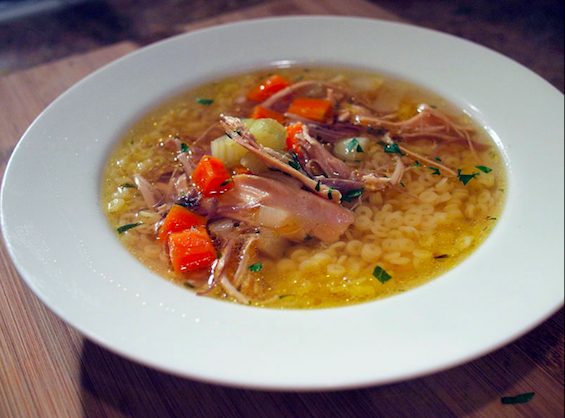
Turkey, Veggie & Barley Soup, an adaptation of Michel Richard’s Chicken, Mushroom & Barley Soup in my book, “Diet Simple: 195 Mental Tricks, Substitutions, Habits & Inspirations”
The second best part of Thanksgiving is leftovers! I try to encourage my clients to focus on healthy leftovers, of course, but perfection is never possible or even a healthy objective. One Thanksgiving, I saved the French Apple Cake dessert for breakfast the next morning (It’s better for your weight and health to eat the most fattening food earlier in the day – Sometimes, it’s all about STRATEGY!). It was one of the best breakfasts of my life!
This is the first recipe in my “Seasonal Batch Recipe” series. My advice: Make the most of the time you spend in the kitchen and ease some stress from your life by batch cooking. I feature batch recipes in my books, Diet Simple and Diet Simple Farm to Table Recipes. Batches are your favorite delicious, quick and easy meals made ahead of time so that you always have something in the freezer or refrigerator, ready to eat on a moment’s notice. And it actually saves time. When you get home from work in the evening, just zap the batch in the microwave and Voilà! Instant delicious, nutritious dinner.
Studies show you’re more likely to eat whatever is in your environment. If you surround yourself with yummy, healthy, wholesome foods, that’s what you’ll end up eating. It’s simple physics: You naturally take the path of least resistance. So why not make things easy on yourself? Plan to make a few batch meals, or even just one, this weekend so you and your family will have their home-made favorites at your fingertips all week long.
Let’s take advantage and start batching with America’s favorite holiday-for-leftovers!
Thanksgiving Turkey, Vegetable and Barley Soup
Adapted from Michel Richard’s Chicken, Mushroom and Barley Soup, excerpted from Diet Simple: 195 Mental Tricks, Substitutions, Habits & Inspirations
4 servings
Nothing could be simpler or more delicate than this dish. The flavors are rich and earthy. It contains all the elements of a complete meal. It’s nutritious and filling to boot. I feel honored that Michel Richard provided this recipe for Diet Simple. It fits perfectly as something you can cook, store in the refrigerator and eat for several meals and is a wonderfully delicious addition.
Ingredients:
2 Tbsp Olive Oil
2 Small Onions, Peeled and Diced
1 Pound Thinly Sliced Mushrooms, or other Vegetables
2 Quarts Unsalted Turkey Stock (defatted)
2 Tablespoons Light Soy Sauce
6 Tbsp Pearl Barley
4 Cloves Garlic, peeled and minced
Salt and Freshly Ground Black Pepper to taste
About 1 pound, boned, skinned and sliced Turkey into bite-size pieces or small slices
About 1-1/2 Cup (about 3 ounces) freshly grated Parmesan Cheese (Optional)
Heat the oil in a heavy medium saucepan over medium-low heat. Add the onion, cover and cook until translucent, for about ten minutes, stirring occasionally. Add the mushrooms – and/or other leftover vegetables. Increase heat to medium-high and cook uncovered until lightly browned, for about five minutes, stirring occasionally. Add the turkey stock, soy sauce, barley and garlic. Simmer gently for 45 minutes to cook barley and blend flavors. Season with salt and pepper. (This can be prepared ahead, cooled, covered and set aside at cool room temperature for up to four hours or refrigerated for several days.)
To serve, bring the soup to a light simmer, add turkey, reduce heat and simmer just until the turkey becomes warm, for about two to three minutes. Ladle into four soup plates. Pass Parmesan, if desired.
Nutritional Analysis:
Calories320
Total Fat5g
Saturated Fat2g
Cholesterol70mg
Sodium1,100 mg
Total Carbohydrate26g
Dietary Fiber6g
Soluble Fiber 1.20 g
Omega 3 Fatty Acids 0.1 g
Sugars1g
Protein 34g
Nutritional Analysis with Parmesan
Calories500
Calories from Fat 200
Total Fat22g
Saturated Fat9g
Cholesterol100mg
Sodium 1800mg
Total Carbohydrate28g
Today’s Lunch: My Take on the All American Hot Dog
Hot dogs! The all-American classic. My favorite version is a hot dog with mustard & onions. How in the world did I come up with that as a go-to meal (besides it being fast and easy)? Who knows! I never liked hot dogs, or mustard, or onions growing up. But, my tastes changed as I grew up. Children have a natural “neofoodphobia,” that is, they’re afraid of new food. But we grow out of it and experimenting with new foods can become a pleasure (uh, well, with most adults anyway!).
I still don’t really care for hot dogs, but I’ve discovered chicken sausages that are lighter and even tastier. They come in all kinds of different flavors: sweet italian, spicy italian, sun-dried tomato and basil, and more. I’ve never liked regular yellow mustard, but when I tried honey mustard, I was hooked. My Swedish mother swears by Swedish mustard, and I like its mild and slightly sweet flavor, too.
So, this has become my “take” on the All (~90%)-American hot dog with mustard & onions. I start with a chicken sausage, which I heat in the microwave.

My “bun” is usually a toasted 100% whole wheat English muffin, because that is what I keep on hand for everything, from creating peanut butter and jelly sandwiches (the peanut butter melts in the nooks and crannies!) to fried or scrambled eggs. Of course, to fit on the english muffin, I slice the chicken sausage/hot dog.

I discovered these wonderfully succulent and sweet mini onions at Quaker Valley Orchards found at either Rose Park’s or Dupont Circle’s Farmers Market. They get chopped and tossed on…

Next, I squirt some swirls of Swedish mustard (I believe it was bought at Ikea) over the top of everything…

I slice up some fresh tomatoes. The Japanese Kumato tomatoes from the grocery store are great this time of year. Add some fresh rosemary from my garden… And Voila!
Bon Appetit!
Meditation on the Beauty of Autumn and Our Ancient Ginkgo Trees
- At November 04, 2018
- By Katherine
- In Articles, News
 0
0
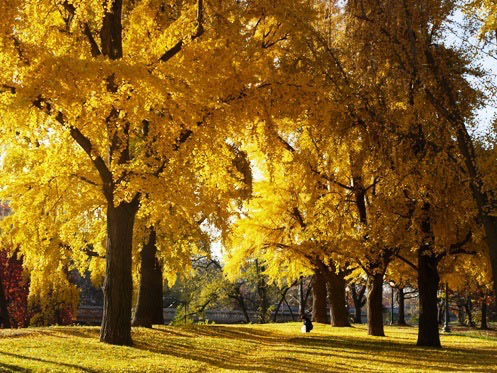
Ginkgo Trees Exhibiting Their Gorgeous Halo of Saffron-Yellow on the Streets of Washington, DC. This particular stand of Ginkgos is in Rose Park in Georgetown, DC’s East Village (photo by Judith Beerman)
Getting out in nature, among trees, in the fresh air, and even a little sun, is essential to your health, according to medical experts. Luckily, here in Washington, DC, there are still wild forests and waterways to enjoy close by and in every direction, but luckily right in the middle of the city, too.
Song for Autumn
by Mary Oliver from New and Selected Poems: Volume II (Beacon press)
In the deep fall
don’t you imagine the leaves think how
comfortable it will be to touch
the earth instead of the
nothingness of air and the endless
freshets of wind? And don’t you think
the trees themselves, especially those with mossy,
warm caves, begin to think
of the birds that will come — six, a dozen — to sleep
inside their bodies? And don’t you hear
the goldenrod whispering goodbye,
the everlasting being crowned with the first
tuffets of snow? The pond
vanishes, and the white field over which
the fox runs so quickly brings out
its blue shadows. And the wind pumps its
bellows. And at evening especially,
the piled firewood shifts a little,
longing to be on its way.
There is a controversy raging about a particular prolific city tree and whether to chop them down. Ginkgo trees are all over DC, on several blocks in Georgetown, a neighborhood here, and have been for at least 40 to 50 years, and some, for over 100, even perhaps 150 years or longer. “The 27th Street stand of Ginkgos in the East Village of Georgetown are the largest and oldest in the United States, according to National Arboretum staff,” said long-time Georgetown resident Nancy Flinn. Some neighbors don’t want them, at least not the female Ginkgos, because at a certain time of the year, they can be pretty messy and smelly. But not everyone agrees with the proposed solution of eliminating the trees. It’s a hot debate in a community, such as Georgetown, which values its trees and historic preservation.

“They’re glorious trees! They shouldn’t cut them down; it’s the reason I live here!” said Georgetown resident and world traveler, Lloyd Thorson, who believes the tree in front of his building, Downing and Vaux, on 30th Street, “must be at least 300 years old.”

Some experts date the tree back to at least the 1840s. Ginkgos grow very slowly, so getting to such a large size indicates it is quite old, probably at least 150 years old. Here, the Ginkgo next to Mr. Thorson, in a closer up photo, shows the wide girth of this ancient specimen.
“There are amazing Ginkgos on the U.S. Capitol grounds, including one near the Supreme Court that dates back to Frederick Law Olmsted’s landscaping [Olmsted designed NYC’s Central Park],” said Melanie Choukas-Bradley, author of The Joy of Forest Bathing: Reconnect with Wild Places & Rejuvenate Your Life, and other nature books, who leads nature walks sponsored by the Smithsonian Associates and the Audubon Naturalist Society. “Behind the Smithsonian castle … there are some beautiful Ginkgos,” Ms. Choukas-Bradley said.

They’s such an old plant species, Ginkgos are considered “living fossils,” dating back 270 million years, first appearing in the early Jurassic period.
“What a fabulous tradition to have in our historic village,” said Outerbridge Horsey, noted architiect and Georgetown neighbor, referring to the the Ginkgos’ provenance. Mr. Horsey is a co-founder of “Trees For Georgetown,” dedicated to “plant and maintain the trees that line the residential streets of our community.” Trees For Georgetown along with Casey Trees and the DC Urban Forestry Division, nowadays, only plant male Ginkgos, such as the “Princeton Sentry” in Georgetown, according to Mr. Horsey.

Ginkgo leaves are uniquely fan-shaped and prized for their beauty.
Ginkgo trees are either male or female. The females develop 1/2 to 3/4 inch seeds with a soft yellow-brown outer layer and a hard shell on the inside. The nut-like shells in the center of the seed are prized in Asia as a delicacy. You’ll often see Asian cooks gathering the Ginkgo seeds on DC sidewalks! To some Georgetowners, though, female Ginkgo seeds, once they drop and get crushed – often on sidewalks – are thought of as a smelly nuisance during the month their berries drop (about November/December). And herein lies the controversy: What to do about those stinkin’ berries?
The people who want to replace the old-growth, large, old female Ginkgo trees with young male trees say the fallen berries are slippery and dangerous, and the smell is noxious (not many would disagree with that assessment!). One neighbor lamented that the berries might affect the real estate value of his home if he needed to sell during the month that the berries have dropped.

Others are passionate about saving the Ginkgo Trees. They say Georgetown’s Ginkgos are historic, “old growth,” huge, beautiful, and provide much needed shade. New Ginkgos would take decades to match the size of the ones they’d be standing alongside in Georgetown. Besides, trees are naturally messy, all have their drawbacks and need maintenance: Slippery leaves… sticky pollen… dirty berries that stain… dangerous branches… nasty bird droppings… Is the only fix to chop down all the trees?
None of the solutions seem perfect. Sweeping or hosing down the Ginkgo berries off the sidewalks works, but only if everyone would cooperate and do their share. One neighbor said, “Little would be the task of most residents along 27th Street [where many Ginkgo trees live] to simply sweep the pods out of harm’s way now and again during the Fall season. Could those residents enjoy the pleasures of being out and about to conduct such sweeping? … [Together] with nearby neighbors? … Trash collectors could perhaps play a role as well.”
In years past, the District sprayed the Ginkgos annually to prevent the trees from reproducing and developing berries in the first place. But the spraying hasn’t been done consistently, and since the Ginkgos have to be sprayed at a specific time in their reproductive cycle, if it’s raining, the spray may not be effective. Perhaps the spraying could be made more effective if the DC government cooperates, and possibly sprayed twice, said one resident.
The Georgetown East Village neighbors who want to cut down their female Ginkgos were given permission to do the deed. But so much community angst has erupted over the possibility of losing these majestic trees, the decision has been put off until the Advisory Neighborhood Commission’s December 3rd meeting, when there will be a discussion and a vote by the entire ANC, the non-partisan neighborhood body made up of locally elected representatives known as Advisory Neighborhood Commissioners. The ANC must “support” removal for it to take place. Previous to that meeting, “there will be public notice and the opportunity to comment,” said Jim Wilcox, the ANC 2E06 Commissioner, who represents the neighborhood in Geogetown’s East Village in which this heated argument about chopping down the Ginkgo trees is on-going.
Enjoy Halloween Candy, But Don’t Get Hooked! 8 Strategies…
- At October 28, 2018
- By Katherine
- In Articles, News
 0
0

Enjoy Halloween Sweets, But Don’t Let Sweets Bingeing Get You Down, Affect How You Look, How You Feel, Or Your Health!
The holidays, wonderful times with family and friends, have their upsides, and their downsides. But you can minimize some downsides by heeding these cautionary tales. Starting with Halloween, the holidays can trip up even the most conscientious and healthy eaters, can wreck the fittest bodies, and ruin the most beautiful skin. This has happened to people I know, who eventually became clients.
One had lost and kept off 20 pounds successfully. The Halloween trap caught her by surprise. She bought several bags of Snickers, her favorite candy bar, and began a binge that didn’t end until the candy was gone – long before Trick or Treat even began! That brought her up a couple of pounds. Next, the holidays came and before you know it, she had gained almost ten pounds before winter was out.
Another client traces the beginning of her adult acne to overeating Halloween candies brought home by her children. She still battles it years later. The research on acne confirms sweets are a primary dietary reason for skin problems, especially acne in adults, and in teens whose acne doesn’t improve at the usual rate, according to Advances in Dermatology and Allergology.
With Halloween and the holidays looming, it is important to determine your strategy for dealing with the temptation of sweets: what you eat, how much, what you bring in your home, and what you serve others.
My philosophy is, without exception, all food should be enjoyed!
But there are special challenges posed with some foods, particularly sweets, which have been confirmed by solid science – it’s not just in your head! Understanding the science behind sweet craving and overeating can help you eat in a way that saves your body, your skin, and your health.
People have an inborn attraction to sweets. If you don’t believe it, simply watch an infant’s response to something sweet versus, say, a vegetable. There is an automatic acceptance, even joy, after eating something sweet. On the other hand, vegetables are an acquired taste, which may take 10 to 20 tries before acceptance, in addition to experiencing positive examples set by peers and parents. This is partly explained by evolution. We’ve been eating naturally sweet foods such as breast milk and fruit for millions of years. They contain life-sustaining nutrients, and a love for those foods helped keep us alive. Also, during evolution, an attraction to scarce calorie-dense foods, such as sweets and fats, improved our chances for survival, according to a NIH Director’s Blog article.
But there are other explanations. The research surrounding our attraction to sweets has stepped up in recent decades. Scientists are grappling with understanding the calorie imbalances causing the obesity epidemic, which is partly fueled by eating too many sweets.
Our brain chemistry holds an important clue. Research shows that sweets, like many antidepressants, increase the brain chemical, serotonin, which helps regulate mood and appetite. Without carbohydrates, your brain stops regulating serotonin. Eating carbohydrates improves mood; which is why a handful of candy corn may help you feel better.
When we’re stressed, anxious or depressed, serotonin levels can drop, and one way people modify their bad mood is by eating carbohydrates. But, Halloween and holiday sweet cravings may be uniquely influenced by seasonal changes, too. Studies show that as days get shorter and we are exposed to less sunshine, serotonin levels drop and this leads to increased carbohydrate cravings in susceptible people. Women are particularly vulnerable to sweet cravings, perhaps because their brains have less serotonin than men, according to the Journal of Psychiatry and Neuroscience. This leads to increased levels of depression, which may be the trigger for overeating in some women, depending on their coping mechanisms for depression.
There have been other explanations for women’s reported increased sweet cravings and indulging. Some researchers attribute the difference to the female hormone, estrogen. It’s been reported that sweet cravings change according to where a woman is in her menstrual cycle, circumstantial evidence that estrogen may play a role. But the findings are inconsistent, as some report increased cravings during menstruation, while others report higher cravings as a premenstrual symptom, a time when serotonin levels may be low. But studies have not confirmed a hormonal connection to sweet cravings, though there can be a connection to depression.
But the bottom line is clear: Females overeat sweets compared to males. A study of female rats found they ate more rat chow when it was sweetened, compared with males, according to a study in the American Journal of Physiology. In animals, having high levels of estrogen is associated with eating more sweets. This theory has yet to be proven in humans.
Cravings and overeating are difficult to study because they can be subjective and multifactorial.
Other researchers stipulate sweet cravings are mainly determined by culture or by psychological and behavioral factors, rather than physiology.
In some cultures, people don’t crave sweets because they haven’t been exposed to them as regularly as Americans. A study of chocolate, for instance, found that American women crave chocolate significantly more than Spanish women. And while a large percentage of American women reported increased chocolate cravings surrounding their menstrual period, Spanish women did not, according to the journal, Appetite.
Other studies confirm that exposure during childhood is the major determinant of what we crave and are susceptible to overeating.
I copied my mother’s love for sweets and baking; it was a fun activity we did together. In college, to combat loneliness, and heck just for fun, I over-indulged my love for sweets (as the pounds went up and up). I would regularly bake my favorite chocolate chip bars and caramel popcorn, both of which I made in childhood. Study after study shows the importance of parental modeling on a child’s preferences, according to a study in the journal, Nutrients.
Availability and proximity are two of the most important factors science have found influence what we crave and overeat and they probably trump all of the other reasons combined, according to a study in the European Journal of Nutrition. When tasty foods, such as sweets, are around, we simply eat more of them, according to The Annual Review of Nutrition.
Chances are, a combination of factors is responsible for cravings and overeating sweets at Halloween and the holidays. Holiday sweets are novel, they only come around once a year. They comes in small pieces so you fool yourself into thinking you’re not eating as much. You put it in bowls around the house and eat it mindlessly.
If you have a strong desire for sweets, it may be a sign that you’re depressed, anxious or stressed. But you don’t have to indulge in sweets to raise your serotonin levels or to feel good. Physical activity, stress management, meditation, spending time with loved ones are activities which will help reduce depression, anxiety and stress. Physiologically, they will increase seratonin and dopamine levels, two brain chemicals responsible for happiness, according to Frontiers in Psychology (My client discovered a psychological basis for her binges, which she is successfully averting these days).
Using candy to feel better is not a great solution for your waist line. It is so high calorie, it doesn’t take much to overeat and forget your weight loss plans. For the same calories in a candy bar, you could eat four apples, or maybe you couldn’t – and that’s the point!
Don’t get me wrong, I’m not urging you to be a Halloween Scrooge. I believe it’s possible to have fun with Halloween, and even eat Halloween candy, but still avoid some of the excesses that many of us have fallen victim to in the past. Here are a few suggestions:
- To reduce the possibility of seasonal cravings, make sure you’re getting 30 minutes to one hour of sunlight each day by taking a walk in the mornings or at lunch. You may be able to “catch up” on the weekend, if you didn’t get enough rays during the week,
- Eat plenty of healthy carbohydrates, such as fruits, vegetables, whole grains and legumes, to keep serotonin at optimum levels and reduce cravings of less healthy carbohydrates, such as refined sugar,
- If you feel driven to eat sweets, it may be a signal that you’re depressed, anxious or stressed. Reduce tension and anxiety by exercising, meditating or talking with loved ones. It’s important to understand the core of the problem and for that, you may need to seek help from a professional,
- If you want to lose weight, keep your candy – or other “extra” calories – to no more than 10% of your daily calories (that’s 200 calories for the average 2,000 calorie intake, or 150 for 1,500 calories). You may even get away with one big splurge on Halloween. But if you splurge for two or more days, it will probably effect your waist line negatively,
- If you can’t resist eating too much candy, wait to buy it on the day of the party or event (or, don’t buy it). This way, the candy won’t be sitting around as a constant temptation,
- Buy only what you need for the event and buy your least favorite candy. Give away the remaining candy at the end of the evening so that there’s nothing left,
- Try fun and healthier alternatives to sweets to have around your home and serve to family and guests, such as popcorn, roasted pumpkin seeds, sliced apples and fruit with nice dips,
- Most importantly, if you do find you overeat, lighten up, don’t dwell on the negative and get over it! Analyze objectively what you can do differently next time,
With awareness and good planning, you can have your sweets and eat them, too!
Cultural Competency Conference 9/18/18 to 9/20/18 Interact Effectively with Diverse Populations: Race, Equity, Sexual Orientation, Privilege, Power, Health Disparities
- At September 18, 2018
- By Katherine
- In Articles, News
 0
0
Cultural Competency Awareness, Action, and Advocacy is a free 3-day online learning event to support your personal and professional growth in key areas of cultural competency. Six interactive sessions will address topics such as privilege and power, race, equity, dis/ability, intersectionality, authentic dialog, sexual orientation, gender expression, and health disparities.
Interactive engagement activities available throughout the week will provide opportunities for personal reflection, making action plans, and building advocacy toolkits.
The virtual conference is an exciting learning event for professionals in all fields to engage in important and timely conversations with colleagues across the country and around the globe. If you haven’t registered yet, do it today by clicking the button below!
Register for the Virtual Conference
Continuing education credits will be available for most sessions!
Visit the individual session pages for additional information.
Join the Storytelling for Cultural Competence Experience!
Storytelling for Cultural Competence offers an advanced learning experience for the Virtual Conference to help you get started on your cultural competence journey, get the most out of the 2018 Virtual Conference, and carry you forward.
CONFERENCE SCHEDULE
Click titles for session descriptions, presenter information and event materials or download the printable flyer.
Tuesday, September 18
11:00 am – 12:30 pm Eastern
Keynote: Fundamentals of Diversity and Inclusion
(Dr. Anne Phibbs)
1:30 pm – 3:00 pm Eastern
Cultural Competency and Authentic Dialog
(Dr. Anne Phibbs)
Wednesday, September 19
11:00 am – 12:30 pm Eastern
Dis/ability, Race, and Equity
(Dr. Maggie Beneke)
1:30 pm – 3:00 pm Eastern
Sexual Orientation and Gender Expression within Families
(Dr. Jenifer McGuire)
Thursday, September 20
11:00 am – 12:30 pm Eastern
Health Disparities at the Intersection of Race, Ethnicity, and Disabilities
(Ms. Barbara Kornblau, J.D.)
1:30 pm – 3:00 pm Eastern
Capnote: Reflecting, Learning and Advocating
(Dr. Anne Phibbs & Andrew Crocker)
© 2018 Military Families Learning Network. All rights reserved.
Healthy Peach Cheesecake Parfait
Two weeks ago, I bought a huge bushel of peaches from my Farmers’ Market, and they were perfectly fresh today! I gave away as many peaches as I could to friends and neighbors when I got home from the market, but there were still some left. To save as many as possible, as soon as I brought them home from the market, I put them gently into my refrigerator, and in a glass bowl, to protect them from bruising, completely unsure as to the outcome.
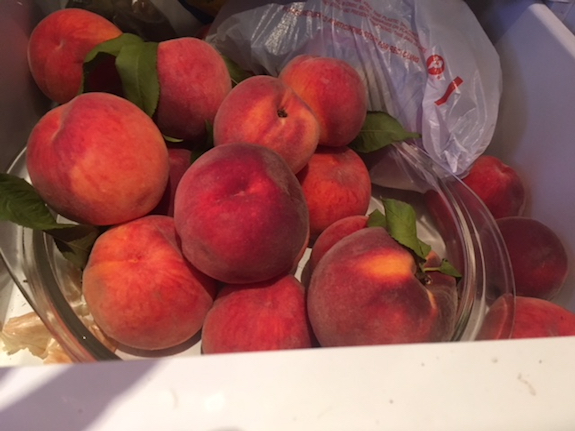
As soon as I got home from the Farmers Market, I carefully placed the ripe peaches in a glass bowl in the refrigerator
I cautiously tried one this weekend for a recipe I was hoping to make, and I was completely surprised at how perfect, sweet, and juicy they still were.
I highly recommend popping by your Farmers Market soon to get what may be some of the last of this season’s peaches.
Healthy Peach Cheesecake Parfait
This is an outrageously delicious dessert, especially because the main ingredient is sweet, tender, locally grown peaches (It was yummy with strawberries, too).
My Salvation Army Addiction Recovery class made this recipe this weekend, and it was a huge hit. My “Nutrition, Health & Wellness” classes include recipes and tastings designed to demonstrate how eating more fruits and vegetables can be deliciously fun. The recipes we make must be healthy, simple, inexpensive, quick, and with no cooking necessary.
For 10 Servings or More
Ingredients:
Use 3 medium bowls, one for each layer:
1 bowl:
Crush in Large Chunks: 9 Graham Crackers or 1-1/2 Cups Granola or Vanilla Wafers
Add Chopped Nuts, if desired
In 1 bowl, toss:
3 Cups sliced peaches
1 Tablespoon Granulated Sugar
In 1 bowl, Blend, then refrigerate until set, if desired:
8 Ounces Low Fat Cream Cheese
1 Cup Nonfat Greek Yogurt
2 Tablespoons Heavy Cream
1/2 Cup Powdered Sugar
1 teaspoon Vanilla Extract
Garnish with extra peaches, granola, and/or chopped nuts on top
Optional: Place a Sprig of Mint on Top
In a wine glass, martini glass, or clear cup, place a layer of the crushed graham crackers, a layer of the cheesecake mixture, then a layer of the sliced peaches. Repeat.
This recipe is adapted from “Life Made Sweeter.” More peach recipes…
The Sweetest Surprise … Yellow Watermelon!
The sweetest watermelon at the moment is yellow, according to moi after tasting every darn watermelon at Sunday’s Farmers’ Market. I’ve always avoided the yellow watermelon; I guess you could say I’ve been kinda prejudiced against a watermelon colored … yellow! But with fruit tasting so bland and mushy this year because of excessive rain, I was desperate to find something sweet. So I reluctantly tried a yellow one at a familiar farm stand. I was surprised by its sweet juicy-ness; the best at the market! Give up any watermelon biases you may have, and just try it 🙂
A yellow watermelon is a natural variety of watermelon hailing from Africa. It’s high in beta-carotene – which provides its yellow color – and vitamin C.
“To broaden the narrow watermelon gene pool, US Department of Agriculture researchers went back to wild watermelon relatives in Africa to find genes resistant to problems like watermelon vine decline, root-knot nematodes, zucchini yellow mosaic virus, and wilting diseases,” According to USDA’s monthly Agriculture Research Magazine.
What to do with yellow watermelon? Of course, any watermelon (even the yellow kind) is great completely naked, cubed in any salad, crushed into popsicle molds or a margarita. Its watery and slightly crunchy sweetness perfectly complements heat or salt in many recipes. Here are just a few of my favorites…
Katherine’s Fresh Summer Salsa with Watermelon
excerpted from Diet Simple Farm to Table Recipes: 50 New Reasons to Cook in Season!
Melon Chunks with Crumbled Feta and Fresh Mint
excerpted from Diet Simple Farm to Table Recipes: 50 New Reasons to Cook in Season!
Nora Pouillon’s Watermelon Gazpacho with Lime and Mint
excerpted from Diet Simple Farm to Table Recipes: 50 New Reasons to Cook in Season!

